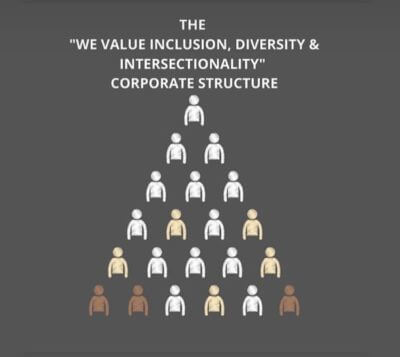
BroadcastOne of my best girlfriend’s posted this the other day on her social. It caught my attention immediately. After giving her the silent “facts” nod I took a screen shot and started thinking about why this grabbed me while skipping through IG stories.
And really, it was the comment she attached to it which essentially read if this is your idea of diversity and inclusion going into 2020, I don’t want to hear it. To which I also silently agreed. I call this Volume 1 because this topic has layers.
So many layers that honestly I was unsure of how I wanted to kick this off. This topic can go in about 1,000 different directions and I did not want to get lost in the sauce. I am a believer at starting from the bottom (now we here, couldn’t resist, thank you Drake) and making our way to the top.
I want to start with the lens in which I see diversity (or the lack thereof) in the broadcast industry. As you know by now, I am here to bring my two cents to the table. Share what I have seen, experienced, and learned.
So this month, here’s what I know. Part of my life’s mission is to open doors that have been closed to people of color in our industry. And when I say open, I really mean break the doors down right off the hinges.
The doors they try to keep hidden from us. The doors they think we don’t belong in. Or the doors that we ourselves believe we can’t get into.
Restricted access. No access. I know we are staring at 2020 but while so much has changed, so much hasn’t.
And don’t be tricked into thinking that a closed door is the only problem here. Sometimes a door isn’t closed. Sometimes they are cracked, just slightly open.
Letting a few of us in at a time, or to meet a quota, or because diversity and inclusion is all of a sudden a trending topic of discussion among companies and across industries (thus the above graphic). So those half open doors, they too need to be completely busted open. Because we are not just a quota.
We are not just part of a trending discussion. We have a proud history in this industry and a bright future. But the work must continue to be done.
Let me start by saying this. People of color are some of the best in the business. I have worked with, known, and witnessed top execs and owners in this industry that look like me.
We are also the talent, the pulse of the culture, and the voice of the communities we serve. Urban radio and tv personalities are larger than life and have platforms that span across the nation in small to large markets. I am of the elder millennial generation that still had boom boxes, tapes, and then cd’s.
I remember listening to the radio every night for the top new songs of the day. It truly was the first time you were hearing a new track. The personalities I grew up with both national and local were the voice of my growing up and the reason I wanted to get into this industry.
They were how I got ready for school every morning (shout out to The Russ Parr Morning Show and The Donnie Simpson Show), how I went into our weekday family dinners (much love to The Daily Drum and The Quiet Storm), and how I ended my night (heyyy Angie Ang! ). I knew that I wanted to be behind the personalities, making the station decisions.
I wanted to be a broadcast executive and in time I would realize that ownership was my true goal. But the further I went in my career, and the more exposed I became to our industry as a whole, I saw less and less of us. And I realized that the people that were making the decisions at the top in most part did not look like us, especially when it came to women of color.
Was this a surprise? Yes and no. I realized that I had to get out of my bubble of black excellence for a bit.
This is what I mean by that. I went to an HBCU where all I saw was successful people of color in every industry, media being no different. We were blessed with many opportunities to meet, greet, interview, and work with top companies with executives of color in radio, tv, film, and more.
So in that lens, I felt big. I felt full. The outside world however, was not as concentrated.
As I began to attend annual industry events across the country I went from feeling big to feeling small. I was a young, black, female in a sea of hundreds of old, white, men. Where were all the people I had met in college?
Where were all of my people? Was I missing a secret meeting? Maybe we were all coming in later?
Nope, we were sprinkled in between. And I do mean far and between. But I took that image and that feeling and used it to propel my mission.
To fill this room with more people who look like me. As you climb the broadcast leadership ladder, you will see less people of color as top executives. When you look to broadcast ownership, the term it’s lonely at the top means exactly that.
There are a couple large players, and I salute them! We need those major players of color, both vets and newcomers into the ownership game. But there are far more smaller entities who are trying to remain competitive in the game, and a few folks like myself who are looking to buy in.
We know the challenges that we face wanting to join the elite levels of broadcast and media ownership, but we take those challenges as opportunities to change the landscape for the next generation. A couple takeaways to start our discussion from an individual level:Get Involved: If you truly want to work in the broadcast industry and become a leader, know the business of the business.
Get involved in your state broadcast association, join media organizations, go to trade shows, get to know the National Association of Broadcasters, Radio Advertising Bureau, the TV Bureau of Advertising, the National Association of Black Owned Broadcasters, and more.
This does not have to start once your career starts, begin to get involved while in college. Internships and industry networking can start now. Pay It Forward: If we are going to change the rooms and tables that we sit at, there must be a pipeline of talent coming after us and with us.
Do what you can to look out for the next broadcast superstar of color. Give someone a chance, expand your recruitment efforts, look at your local HBCU’s. Mentor, mentor, mentor even if it’s informal or unofficial.
Be that person that you may have not had. Get Out of your Bubble: As I mentioned, I had to get out of my own bubble. The bubble that lifted me up, but also at times created a false sense of reality when it came to representation.
Get uncomfortable to make a difference. I was fortunate to be able to speak on this very topic with a fellow girl boss on a mission not too long ago. Check out the interview here.
Thank you again for the platform Chelsi! Next month we will tackle facts, stats, and possible solutions to once again creating a pipeline of successful people of color in executive roles and at the ownership level. Have a wonderful and safe holiday!
Until 2020… Share. Hustle. Shine.























